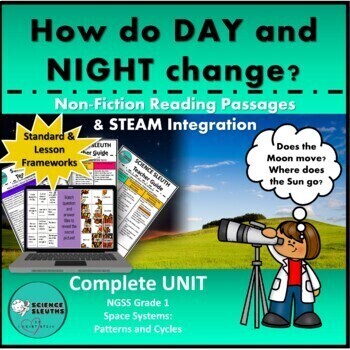Day & Night - Space Systems: Patterns and Cycles NGSS Grade 1 - Science Sleuths
- Google Drive™ folder

What educators are saying
Also included in
- First Grade NGSS Science curriculum for the entire year!Use Science Sleuths to teach NGSS Space, Animal Traits, and Light and Sound for first grade. Includes a complete integrated unit with teacher standard practices in the disciplinary core ideas, science and engineering practices, and crosscuttingPrice $21.00Original Price $27.00Save $6.00
Description
BOOM! Science Sleuths has arrived!
Instruction for day and night science standards will never be the same again when your students become science sleuths and earn achievement badges!
Use Science Sleuths to teach NGSS Space Systems: Patterns and Cycles for first grade. Includes a complete integrated unit with teacher standard practices in the disciplinary core ideas, science and engineering practices, and crosscutting concepts. Other subject connections to ELA, Math, and Art are also included.
Students will read to learn with a grade level appropriate easy ready or story activity pages. Google version includes easy ready and activity pages, also.
This unit encourages students to think critically across subject matter. 3 Moon poems with an enrichment project are also found within the unit. You will never need another resource for your science standards and STEM/STEAM learning! Your students will also get up and move and use simulation cards to create the orbit of the Earth around the Sun.
This unit is PDF formatted and made for Google formatted!
Teacher Guide Includes:
•General Instructions
•NGSS Standards and Lesson Correlations
•Phenomenon Instruction/ Questioning Tips/Badge Concept
•Other Subject Correlations
2 Badge Display Patterns
2 Badges
•Lesson Completion Badge
•Bonus Badge
Phenomenon Image
Story Pages:
How do day and night change?
Can you label the seasons?
Seasons Worksheet
Science Sleuth Challenge
When the Moon comes out…
Day and Night
Sun, Moon, Earth Orbit Card Simulation
Moon Phases
Moon Phases Data Chart
Moon Data Class Chart Examples
Moon Poems
- 3 Enrichment Poems
Super Sleuth Challenge for Moon Poems
Easy Reader
- 9 pages
Secret Picture Tiles Picture Key for print and made for Google version






